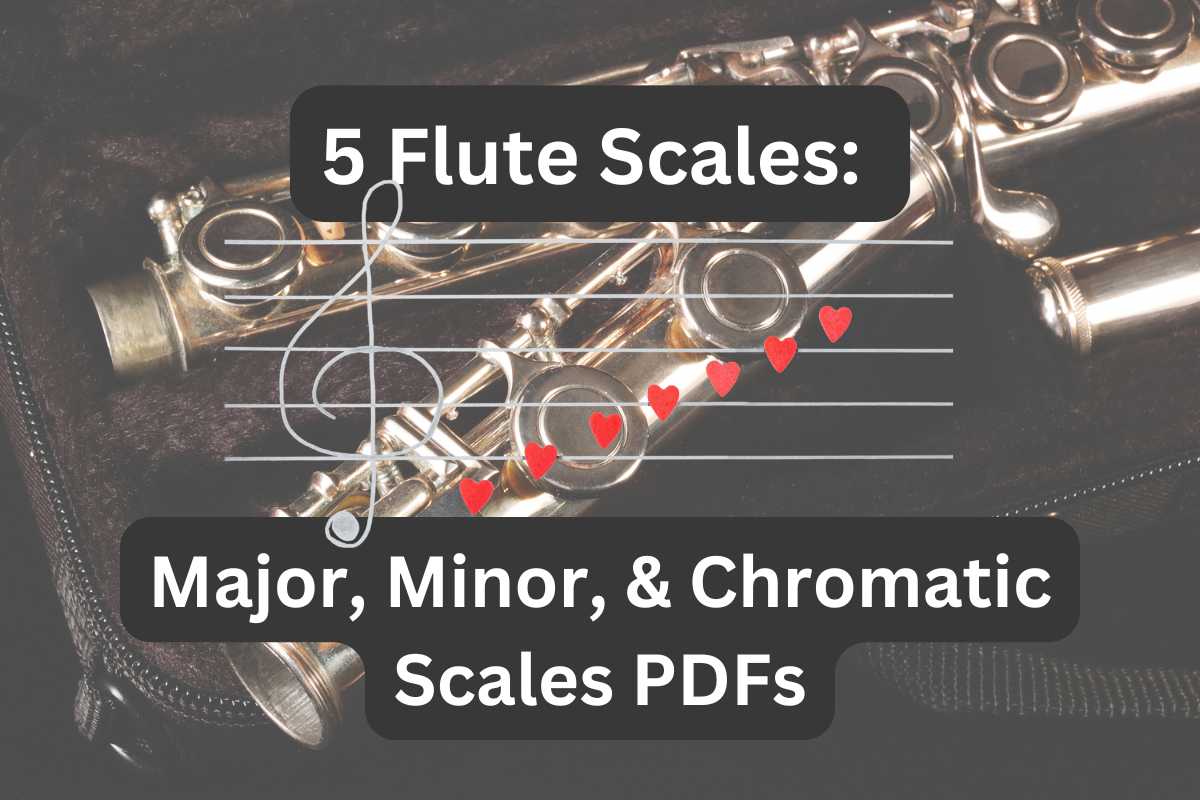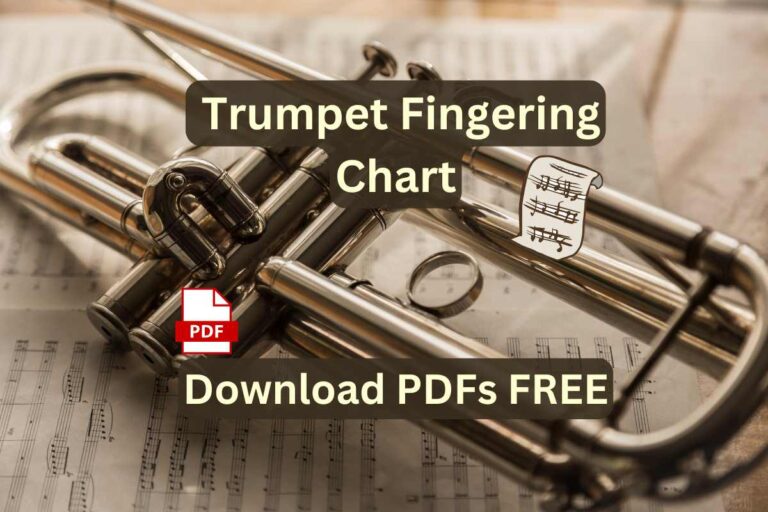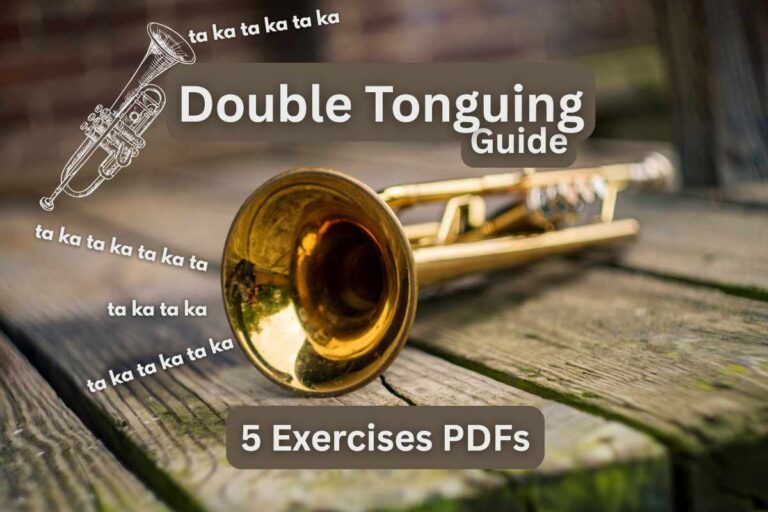5 Flute Scales: Free Major, Minor, & Chromatic Scales PDFs & Best Tips

Flute scales build finger speed, tone control, and muscle memory. Every great flute player practices scales daily. These exercises are the foundation of every song, solo, and piece you’ll ever play.
We’re talking about five must-know scales: major, natural minor, harmonic minor, melodic minor, and chromatic. Each has its vibe! Learn them all if you are serious about the flute. Download PDFs of each scale and practice anywhere, anytime!
If you’re serious about mastering the flute (or just want to impress people), you need to learn them all.

What Are Flute Scales?
Flute scales are notes in a specific order of whole and half steps. Think of scales like a musical workout—they train your fingers, improve technique, and help you recognize patterns by ear.
We’re diving into five main flute scales:
- Major (bright, happy vibes)
- Natural Minor (a bit moody, kinda mysterious)
- Harmonic Minor (spicy, exotic sound)
- Melodic Minor (smooth, jazzier feel)
- Chromatic (every single note, total workout)
| Scale Type | Mood | Pattern | Example (C Major / A Minor) |
|---|
| Major | Bright, happy | W-W-H-W-W-W-H | C – D – E – F – G – A – B – C |
| Natural Minor | Dark, moody | W-H-W-W-H-W-W | A – B – C – D – E – F – G – A |
| Harmonic Minor | Dramatic, exotic | W-H-W-W-H-1½-H | A – B – C – D – E – F – G# – A |
| Melodic Minor | Smooth, expressive | Asc: W-H-W-W-W-W-H / Desc: W-W-H-W-W-H-W | A – B – C – D – E – F# – G# – A (up) |
| Chromatic | Technical, versatile | ½ steps only | C – C# – D – D# – E – F – F# – G – G# – A – A# – B – C |
Each type of scale sets the mood. Major scales sound bright and cheerful, while minor scales feel deep, sad, or mysterious. Chromatic scales are great for finger agility and smooth playing.
Almost every piece of music is built on flute scales. The better you know your scales, the easier it is to play any song
1. Major Scales (Flute Player’s Bread & Butter)
Major scales are the basics of music. Every major key song comes from a major scale. They have a bright, happy feel and make melodies sound smooth. The major scale pattern is: whole step, whole step, half step, whole step, whole step, whole step, half step — W-W-H-W-W-W-H.
🎯 Why Practice Them?
- Helps finger coordination (less fumbling, more flow)
- Strengthens breath control (for fuller, steadier notes)
- Makes sight-reading way easier
Example: C Major Scale (No Sharps, No Flats)
C – D – E – F – G – A – B – C
2. Natural Minor Scales (Moody & Mysterious)
Natural minor scales have a dark, mysterious sound. The natural minor scale pattern is: whole-half-whole-whole-half-whole-whole — W‑H‑W‑W‑H‑W‑W.
🎯 Why Practice Them?
- Expands dynamics & expression (feels deeper, richer)
- Essential for minor key music (not everything’s happy, right?)
- Builds strength in low & high registers
Example: A Natural Minor Scale (No Sharps, No Flats)
A – B – C – D – E – F – G – A
3. Harmonic Minor Scales (Spicy & Bold)
Harmonic minor scales have a raised seventh note — they have that exotic, almost haunting sound (think Middle Eastern or classical drama vibes).
🎯 Why Practice Them?
- Sharpens ear training (helps hear unique intervals)
- Strengthens fingers (some tricky jumps!)
- Helps with interval jumps
Example: A Harmonic Minor Scale (Raised 7th Note!)
A – B – C – D – E – F – G# – A
4. Melodic Minor Scales (The Smooth One)
Melodic minor scales change depending on which direction you play them. They shift depending on if you’re going up or down. When ascending, they’re closer to a major scale. When descending, they shift back to natural minor.
Melodic scales are often called the most “singable” minor scales.
🎯 Why Practice Them?
- Boosts phrasing & musicality (think flowing melodies)
- Prepares you for complex music (especially jazz & classical)
- Teaches scale flexibility (changes in different directions)
Example: A Melodic Minor Scale (Changes on the Way Down!)
Ascending: A – B – C – D – E – F# – G# – A
Descending: A – G – F – E – D – C – B – A
5. Chromatic Scales (Ultimate Finger Workout)
Chromatic scales hit every note! That means there’s no skipping — just one step up at a time. They help with speed and accuracy. If you struggle with fast runs (or high notes sound weak), chromatic scales fix that fast!!
🎯 Why Practice Them?
- Builds fast, fluid fingerwork (zero hesitation!)
- Strengthens control over high & low notes
- Makes tricky runs feel easy
Example: Chromatic Scale (All The Notes!)
C – C# – D – D# – E – F – F# – G – G# – A – A# – B – C
Looking for a new flute? First, read my post about “Best Intermediate Flute – 9 Options – Learn When To Update Beginner and How to Pick The Best Flute“.
Tips for Practicing Flute Scales
Most beginner flutists play their scales the exact same way — straight up, straight down, even rhythm, no surprises. And then they wonder why their playing feels stiff or why fast passages still trip them up.
You need to make your scale practice work!! Switch up how you play them — use different rhythms, change articulations, and add dynamics.
So, try these three techniques instead of just going through the motions. For more details, read my “11 Flute Tips — Easy Beginner Flute Guide To Improve Flute Tone.“
Vary Your Rhythms
Take a basic scale — like G major — and try long-short-long-short rhythms (dotted notes), or go for triplets (three notes per beat). This breaks up the monotony plus prepares you for actual passages.
“A good place to start is playing your flute scales with different rhythms. It can make practice less dull and helps you prepare for how they appear in music.”
Try adding different rhythms within each measure of your scales. Play quarter notes followed by sixteenth or mix triplets with regular eighth notes. This keeps your mind from going on “autopilot” during practice.
Change Up Your Articulations
Different articulation styles help your fingers and tongue coordinate better. Switching articulations forces you to engage different muscles, which makes hard passages feel easier.
Try slurring every note. Then tongue every note. After that, mix it up — maybe slur two notes, then tongue two. You can add accents on the first note of each beat for an extra challenge. The more articulations you use, the more control you have.
When learning flute scales, start with all-slurred playing — focus on tone quality!! Tonguing can sometimes mess up your tone if added too quickly.
Play with Dynamics
Crescendo and decrescendo make your tone way more expressive and strengthen your breath control. Practicing dynamics in scales is one of the best ways to improve tone quality.
Try starting super soft (pp — pianissimo), then gradually get super loud (ff – fortissimo) as you go up the scale. When you come back down, fade to soft again. Another great trick is reversing it — start loud, get soft at the top, and then build back up.
You could even practice each scale as one large crescendo or diminuendo. Changing dynamics prevents you from going on autopilot and forces you to listen to your tone quality (something we all need to do more).
Break Flute Scales Into Small Chunks
Don’t tackle an entire scale at once. Working in small sections gives your brain and fingers time to learn the patterns. Break each scale into easy one-inch chunks and play each chunk ALL-SLURRED
Start by playing just five notes of a scale until you feel comfortable. Then expand to a full octave, and eventually to two octaves. These small steps make learning flute scales much less overwhelming.
Flute Scales Common Challenges
Scales are tough (some are just brutal). Tricky fingerings, fast tempos, and that never-ending controll for smoothness — so easy to get frustrated!! The good news? Most problems have fixes—and they’re actually pretty simple.
Finger Coordination
One of the biggest struggles is finger coordination. If your fingers aren’t moving together, the flute scales sound messy…
…Slow it down! Play at half speed before adding speed. It forces your fingers to move evenly instead of tripping over each other.
If a note feels awkward, check if there’s an alternate fingering. Start learning “Flute Alternate Fingerings: A Complete Guide for Beginners“.
Use a metronome to keep your pace steady. Practice flute scales one note at a time, focusing on clean transitions.
Try “ghosting” ( “spider walking”) the scale — move your fingers without blowing air. It trains muscle memory so that when you add air, it just works.
Breath control
If you feel like you’re always gasping, the problem isn’t the flute — it’s your breath. Most beginners run out of air mid-scale. Without proper breath control, your notes sound uneven and “choppy”.
The trick is deep belly breathing, not shallow chest breaths. Deep breathing exercises strengthen your diaphragm. Lie on your back with a book on your tummy. Raise the book when you breathe in. Practice taking slow, deep breaths for five minutes each day.
Find more details in my “Flute Embouchure: 7 Top Tips to Develop A Strong Technique” post.
Practice long tones — holding a single note for as long as possible. This strengthens your lungs and improves control. Try “snake breathing” — inhaling deeply through your nose and exhaling slowly through the flute.
Embouchure / Tone
Focus on your embouchure (how you shape your mouth). Keep it steady and relaxed. You’ll get weak, airy tones when your lips aren’t sitting right on the headjoint.
Make sure your air is steady. Don’t let up on weak notes — keep your air fast and controlled. Check your lip placement. A tiny roll in or out changes the sound completely! If high notes sound too strong, don’t force them — use a lighter air stream instead.
Try some lip buzzing without the flute to build your facial muscles. Daily long tone practice helps, too.
Conclusion: Flute Scales
Flute scales shape your technique, help with finger speed, and make you sound way more “pro”.
Practice more fun by playing flute scales with emotion, using different rhythms, or turning them into technical exercises. Scales don’t have to be boring — make a creative playground!
If you haven’t grabbed the free flute scales PDFs, don’t wait! They’ll make practice way easier!!






